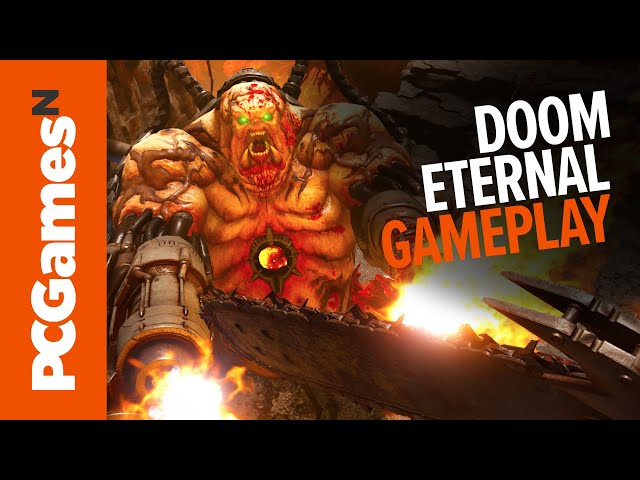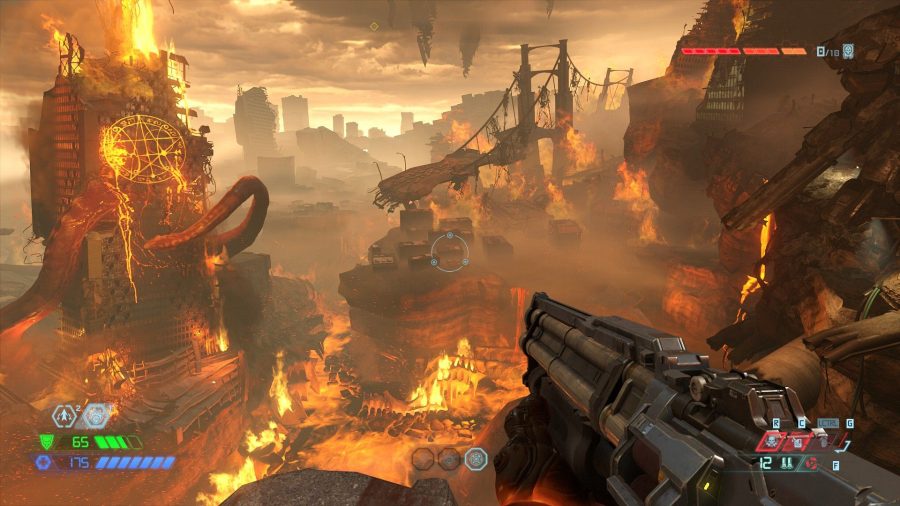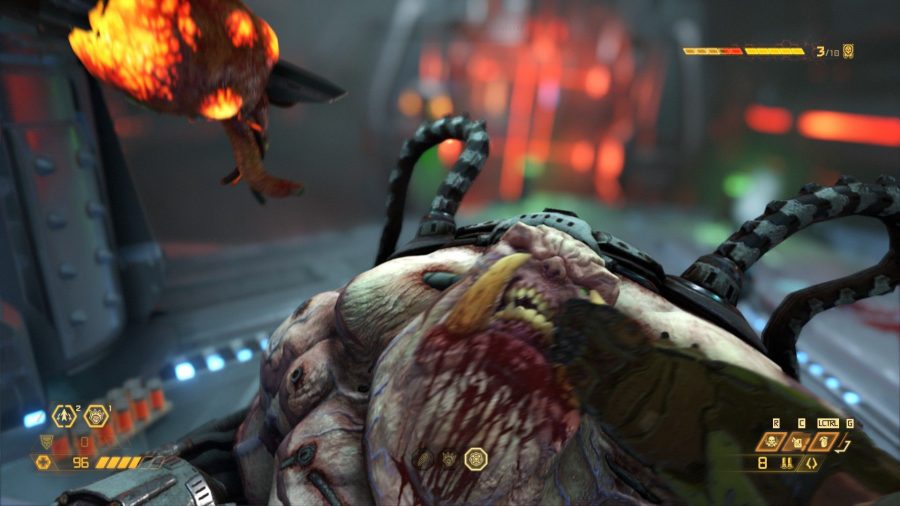Our Verdict
Id stumbles very occasionally in its ambition to expand on 2016, but you won’t care when you’re enjoying the best combat in shooters. Pure, animalistic catharsis.
I was a little worried about Doom Eternal. Doom 2016 was a tightly focused reboot of the IP, whereas developer id Software’s expansive ambition for the sequel has been clear in marketing that shows us taking on angels and in talk of setting up a Doom universe.
But Doom began life in another era of videogames (one could say it began another era of videogames). Its original conceit, to which id has remained hearteningly loyal, was a thin excuse to let you spray demon gibs around Phobos. Its entire ‘story’ fit in a couple of paragraphs at the end of each episode. It was a simpler premise for a simpler era in gaming, and I was concerned that with Doom Eternal, id’s ambition would expose its limitations.
If you’ve scrolled to the bottom to check the score already (we all do it), you’ll have noticed that I like Doom Eternal a lot. My concerns weren’t entirely unfounded, it turns out, but it’s hard to care when the important stuff is this damn good. No other shooter comes close. In 2020 as in 1993, id reigns supreme as the master of FPS combat.
I loved Doom 2016 but after my first hands-on with Doom Eternal, I wrote that the sequel makes its forebear feel slow and sluggish.
That sense has only deepened after finishing the game. Id has looked for every opportunity to add movement and skill to the strong foundations of 2016: the dash ability, the super shotgun’s meat hook, and the destructible demons system are the most important new ingredients.
Dashing offers a multi-directional jolt of speed that’s essential for dodging enemy attacks, evading missile lock-ons, and traversing gaps in Eternal’s enlarged arenas. The meat hook anchors you to a demon and flings you through the air. It’s not quite flying, but it’s just as empowering: whether tinged with warm relief when you use it to escape a losing situation, or with retribution, as you swoop toward a key target with both barrels primed.
Demons are destructible now, which means you can see chunks of flesh physically shredding off them as you reduce them to hamburger meat with a chaingun, adding a whole new dimension to its sense of impact. Not only this, but many demons have weak points that oblige a quick change in tactics: finding a spare half-second to quickscope an Arachnotron’s gun turret or force-feed a grenade to a Cacodemon is the best way to reduce their threat, and another way to feel like a badass if you pull it off.
Glory kills return from 2016 largely unchanged but for the addition of the Flame Belch, which fills a significant gap in the system by allowing you to generate armour from demons by lighting them on fire first. It’s hugely rewarding to douse a horde of demons with napalm, blow them all up, and watch your armour refill as you pirouette among flying green shards and falling gibs like Gene Kelly singing in the brains. Does it make any sense that demons should drop different resources based on how they’re killed? No. Will you care? Also no.

Glory kill animations are as thrillingly sick as ever, and I wonder if id has reserved extra savagery for the most bothersome enemies. I feel a grim sense of justice each time I break a Whiplash’s arm at the elbow and then shove the bone through the back of its throat. As in 2016, you’re briefly invincible while a glory kill plays out. This offers a minute but essential opportunity to catch your breath, punctuating the headbanging rhythm as God’s own music (metal) blares, and you literally rip and tear your way through Hell’s minions.
Those minions play their part well. Most have had redesigns to accommodate weak points and destructibility, so even more so than in 2016, each requires different tactics and weaponry to take down, and every such weapon is a joy to use. Unlike 2016, there isn’t a weak link among Eternal’s arsenal. The boring plasma rifle that could’ve been copied from any number of sci-fi movies has been replaced with a beefier version that’s true to the design of Doom 1993. I was a fan of the gauss cannon in 2016, but I’m an even bigger fan of the ballista that is its functional replacement: charging up a shot with its destroyer blade mod sees the bolt and then the bow string pull back in a series of menacing thunks, the bow quivering with tensile power ready to be unleashed.
Combat in Doom Eternal is pure id, in every sense. It’s intense, exhausting, and stupendously thrilling – like a rollercoaster made of Red Bull and rough sex in videogame form. Id is clearly inviting more people to ride, too – lose twice to a boss and you’ll be given the option to activate Sentinel Armour, which massively reduces incoming damage. This doesn’t affect progression, and nor does adjusting the difficulty. At the end of each level, you’ll unlock the option to fast travel around the map, which is very helpful for picking up missed collectibles. Visually, everything is much more obvious and readable than in 2016: Codex entries are big floating pages rather than small, easily missable PDAs left on desks.
While well intentioned, this push for accessibility goes too far in places. In Doom 2016, subtle green lights illuminated the critical path to help steer players through a level. In Eternal, the subtlety is abandoned. Even in the bowels of Hell, demonic idols and cages full of tortured souls are marked with friendly lights saying ‘punch me here’ or ‘jump on me to progress’. Eternal’s levels are huge – far larger than 2016 – and aren’t trivial to navigate, but this is overkill. After a savage demon attack I’m pretty sure they’re not my biggest fans, but then whoever’s built their fortresses of terror undoes all that good work by putting up signs that basically say ‘this way to freedom.’ Perhaps they’re just toying with me. Granted, Doom has always been ‘gamey’ – to arrive in Hell and see every room littered with health and ammo pickups has always required some suspension of disbelief – but Eternal sometimes asks too much of this indulgence.
All that said, there is fun to be had in just moving around the levels. Doom 2016 did, at times, feel a bit flat, but here the addition of climbable walls and monkey bars from which to swing enlivens the downtime between fights. Doomguy’s strength is palpable every time he slams into a wall, and stringing together a sequence of dashes, swings, and climbs to cross yawning chasms while dodging fiery chains is yet another way in which you feel dynamic and capable. It also enables id to hide secrets in new and fiendish places. If you’re not a fan of first-person platforming, be advised: there’s a lot of this. Doomguy is basically Mario with guns and ‘roid rage now.
It’s appropriate that you move through the world with such ferocity, as id has done a brilliant job in making it utterly horrifying (apart from those cheerful signposts). Stop and look for too long at the writhing cancerous masses of Hellish tissue slowly enveloping the Earth and you may feel physically sick. Consider that each of the thousands of pairs of grasping limbs reaching from Hell’s walls is a person, with memories and loved ones, and you’ll feel pretty strongly motivated to kill some sodding demons.
Id has even created a Heaven that could fairly be described as paradisiacal, yet which exudes a horror all its own: a disquieting coldness, achieved through angelic choirs that sing in a delicate whisper and a skybox full of green-blue nebulae as cold as the deep sea. Dark red trees grow from black slate, like ornaments in a Scandinavian show home. Doom 2016 did what it could do vary its environs, but Doom Eternal is a galaxy-spanning odyssey by comparison, each level as distinct and grotesquely gorgeous as the last. It’s hefty, too: a completionist playthrough (I only missed three collectibles) took me around 25 hours on ultra-violence difficulty, which offered a good challenge.
Through it all, the Doom Slayer has a single, pure purpose: to stop the demon invasion of Earth, regardless of what it costs. That purpose is sharpened by contrast with other characters, who, to my outrage and yours, pathetically argue that any other response is appropriate. King Novik of the Night Sentinels, the Slayer’s former comrades-in-arms, implores him to reconsider his crusade, claiming “they are no longer your people to save.” Obviously, the Slayer turns his back and cracks on.
The UAC, instigator of the whole mess, wheels out another holographic spokesperson who asks humanity, with galling complacence and Kafkaesque absurdity, to accept the Hellish terraformation of Earth and submit to eternal torment.
Doom Eternal isn’t universally brilliant. In shooting for challenge in its combat and puzzles, it sometimes hits frustration. Signposting is over-eager and somewhat undoes the notion that the world is hostile. Id occasionally overreaches in its desire to expand a simple premise. But when it looks and feels this good those wrinkles fade from view. Each fight is a maelstrom of somehow readable violence with all the cathartic power of a temper tantrum, and when the gore settles, you’ll feel every bit as spiritually purged as the Earth you’re saving.
Doom Eternal’s multiplayer, Battlemode, will only go live when the game releases on March 20. This review is solely focused on the campaign.















